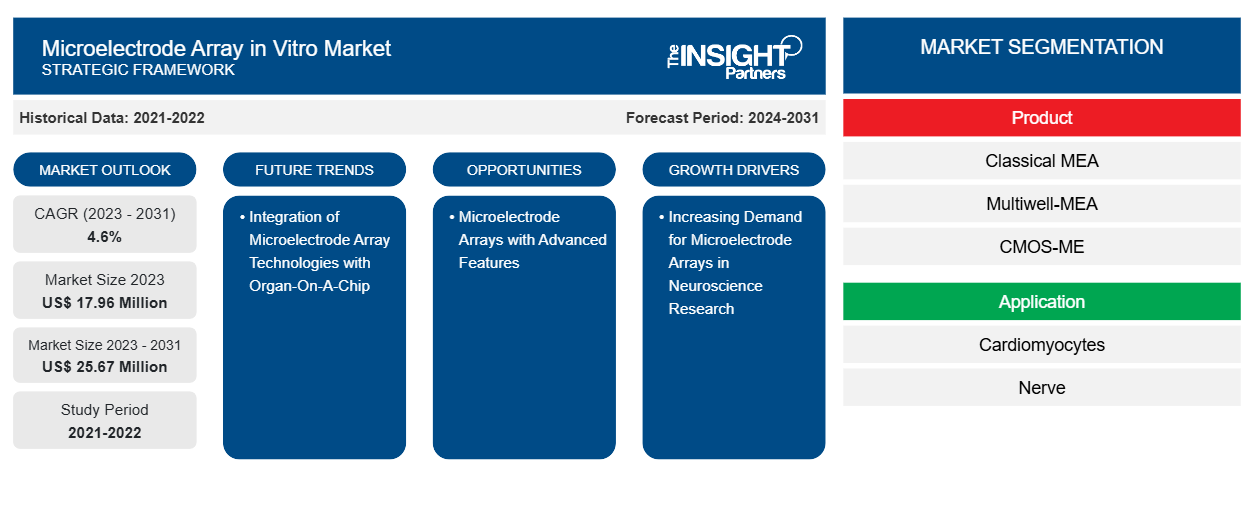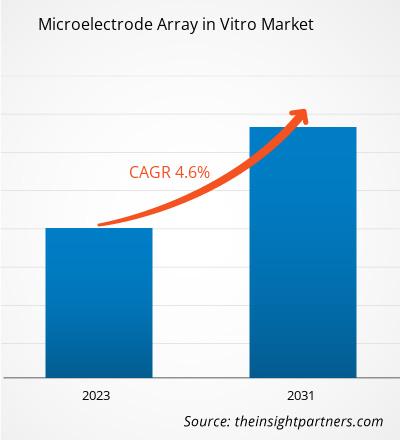The microelectrode array in vitro market size is projected to reach US$ 25.67 million by 2031 from US$ 17.96 million in 2023; the market is estimated to record a CAGR of 4.6% during 2023–2031. Integration of microelectrode array technologies with organ-on-a-chip is likely to bring new trends in the market in the coming years.
Microelectrode Array in Vitro Market Analysis
Organ-on-a-chip systems are designed to replicate the physiological conditions of human organs using microfluidics and engineered tissues. When combined with microelectrode array technology, these systems can monitor electrical activity in real-time, providing insights into the functional responses of the organ models. For instance, a "heart-on-a-chip" that integrates a microelectrode array can offer data on cardiac electrophysiology, enabling researchers to evaluate the ways different compounds impact heart rhythm and contractility. This information is essential for understanding drug-induced cardiotoxicity, which poses a significant concern in pharmaceutical development. For instance, in September 2022, NETRI, a neuro-organs-on-chip start-up, partnered with Axion BioSystems to create microfluidic devices with high-throughput microelectrode arrays. This advanced technology will allow neuroscientists to noninvasively measure the electrical activity of neural cells in complex in vitro models, accelerating therapeutic discovery. The microelectrode array is crucial to the center’s organ-on-chip research, which seeks to improve biological models while reducing animal testing. The research is focused on brain-on-a-chip technology for studying neurodegenerative diseases, heart-on-a-chip technology, and blood-brain barrier modeling. Therefore, the integration of microelectrode array technologies with organ-on-a-chip devices is expected to bring new trends in the market growth in the coming years.
Furthermore, key players focus on developing technologically advanced microelectrode arrays with innovative features is anticipated to create significant opportunities in the market.
Microelectrode Array in Vitro Market Overview
The microelectrode array in vitro market is experiencing significant growth due to its critical role in studying cellular activity, particularly neurobiology, cardiology, and pharmacology. MEAs consist of multiple miniature electrodes arranged in a grid, enabling real-time monitoring of electrical signals from cells. This technology is increasingly utilized for drug development, disease modeling, and high-throughput screening, driven by the rising incidence of chronic diseases and advancements in research methodologies.
Customize This Report To Suit Your Requirement
You will get customization on any report - free of charge - including parts of this report, or country-level analysis, Excel Data pack, as well as avail great offers and discounts for start-ups & universities
Microelectrode Array in Vitro Market: Strategic Insights

-
Get Top Key Market Trends of this report.This FREE sample will include data analysis, ranging from market trends to estimates and forecasts.
Microelectrode Array in Vitro Market Drivers and Opportunities
Rising Focus on Developing Alternatives for Animal Testing Models
Animal models are used widely in biomedical research for human-specific diseases. However, various drug toxicology studies demonstrate that animal models cannot always predict human drug response. This is because there are wide variations in the metabolism of drugs and toxins in humans compared to animals, which makes it nearly impossible to study drug metabolism in experimental models such as laboratory rodent species. Additionally, several regulations have been implemented in recent years, particularly in Europe and North America, that restrict animal use in research activities. Similarly, Cruelty-Free International and the Fund for the Replacement of Animals in Medical Experiments are a few regulatory bodies that oppose animal-based models for research. Such strict regulatory requirements for assessing the toxicity of chemicals, cosmetics, and environmental compounds drive the adoption of microelectrode arrays for in vitro testing. As a result, pharmaceutical and biotechnology companies are encouraged to implement microelectrode array-based testing platforms for screening the neurotoxicity and cardiotoxicity of drugs.
Manufacturers of microelectrode array systems such as BMSEED offer proprietary stretchable microelectrode arrays (sMEAs) and MEASSuRE platform. The use of sMEAs enhances the validity of in vitro experiments by replicating the electrical and mechanical environment of cells, similar to their conditions in vivo, within a controlled setting. By creating a biomimetic environment for cells and tissues, sMEAs can closely mimic the human body, providing more accurate, human-relevant data early in preclinical research. This approach aims to reduce failure rates in human clinical trials.
Thus, the rising focus on developing alternatives for animal models for research fuels the microelectrode array in vitro market growth.
Microelectrode Arrays with Advanced Features
In recent years, in vitro microelectrode array technology has made significant advancements that enhance its ability to study cellular activity, especially in the fields of neurobiology and cardiology. A few of the key improvements in the microelectrode array are mentioned below:
- 3D Fabrication Techniques: The development of a 3D microelectrode array allows for the creation of more complex and physiologically relevant cellular environments. These arrays better replicate the natural structure of tissues, facilitating improved interactions between electrodes and cells. This enhancement is essential for applications in drug development and disease modeling, as it enables high-throughput screening assays and real-time health monitoring. In January 2023, BMSEED filed a non-provisional patent application for 3D microelectrode array technology for in vitro research. The technology underlying the filed patent develops a microelectrode array with adjustable 3D pockets with embedded electrodes that physically wrap around the organoid. This array will enable researchers to record neural signals from most of the surface (estimated to be 80%) of physiologically intact organoids.
- Integration with Advanced Biosensors: Incorporating biosensors into microelectrode arrays enhances their functionality, allowing for the detection and quantitative analysis of biomolecules and chemical compounds. This integration expands the range of applications for microelectrode arrays beyond basic cellular recording.
- Enhanced Electrode Design: Advancements in electrode design, including miniaturization and increased electrode density, enable more precise recordings of cellular activity. This is especially beneficial for studying complex neural networks and cardiac tissues. MicruX Technologies, an innovative technology-based company, offers microelectrodes on the basis of pinholes arranged in a honeycomb microstructure. This thin film features a working electrode with a sensor that is coated with a photoresist containing 5 µm or 10 µm pinholes, which create an array of ultramicroelectrodes.
Thus, the launch of advanced microelectrode arrays is expected to offer lucrative growth opportunities for the manufacturers operating in the microelectrode array in vitro market during the forecast period.
Microelectrode Array in Vitro Market Report Segmentation Analysis
Key segments that contributed to the derivation of the microelectrode array in vitro market analysis are product, application, and geography.
- Based on product, the microelectrode array in vitro market is segmented into classical MEA, multiwell-MEA, and CMOS-ME. The multiwell-MEA segment held the largest share of the microelectrode array in vitro market in 2023.
- By application, the market is categorized into cardiomyocytes, nerve, and others. The cardiomyocytes segment held the largest share of the microelectrode array in vitro market in 2023.
- By geography, the market is categorized into North America, Europe, Asia Pacific Middle East and Africa, South and Central America. The North America held the largest share of the microelectrode array in vitro market in 2023.
Microelectrode Array in Vitro Market Share Analysis by Geography
The geographic scope of the microelectrode array in vitro market report is mainly divided into five major regions: North America, Europe, Asia Pacific, the Middle East & Africa, and South & Central America. North America dominated the market in 2023. Investors are increasingly focusing on companies that produce high-throughput microelectrode arrays for in vitro research, a critical requirement for research institutions, pharmaceutical industries, and the biotechnological sector. Innovations in CMOS-based microelectrode arrays, stem cell research, neuroprosthetics, and in vitro toxicology testing are driving the demand for microelectrode arrays. In June 2020, Georgia State University Research Foundation, Inc. was granted US$ 197.56 million by the US National Science Foundation for their project, which involved the development of microelectrode array sensors for SARS-CoV-2 and other RNA viruses. The project offered a unique opportunity for measurement science to tackle a societal and global crisis through innovative research.
The microelectrode array in vitro market in Canada is experiencing growth owing to advancements in neuroscience and biomedical research and supportive government policies. Microelectrode arrays play a critical role in recording and stimulating neural activity, making them essential in academic and clinical settings. Recent innovations in Canada include improving microfabrication techniques and developing new materials that enhance microelectrode array sensitivity and functionality. Universities and research centers in Canada are leading the development of microelectrode array technology. Researchers, particularly at institutions such as the University of Toronto, are integrating biosensors with microelectrode arrays to better detect biomolecules, which is vital for drug development and disease therapies. The University of Alberta utilizes microelectrode arrays to study neuronal behavior and drug interactions to enhance the understanding of neurological disorders and potential treatments. The government of Canada supports the development of microelectrode arrays through funding programs, such as those offered by the Canadian Institutes of Health Research (CIHR), which provide grants for microelectrode arrays-related neuroscience projects. This funding promotes collaboration between academia and industry, bridging the gap between research and practical applications.
Microelectrode Array in Vitro Market Regional Insights
The regional trends and factors influencing the Microelectrode Array in Vitro Market throughout the forecast period have been thoroughly explained by the analysts at The Insight Partners. This section also discusses Microelectrode Array in Vitro Market segments and geography across North America, Europe, Asia Pacific, Middle East and Africa, and South and Central America.
Microelectrode Array in Vitro Market Report Scope
| Report Attribute | Details |
|---|---|
| Market size in 2023 | US$ 17.96 Million |
| Market Size by 2031 | US$ 25.67 Million |
| Global CAGR (2023 - 2031) | 4.6% |
| Historical Data | 2021-2022 |
| Forecast period | 2024-2031 |
| Segments Covered |
By Product
|
| Regions and Countries Covered |
North America
|
| Market leaders and key company profiles |
|
Microelectrode Array in Vitro Market Players Density: Understanding Its Impact on Business Dynamics
The Microelectrode Array in Vitro Market is growing rapidly, driven by increasing end-user demand due to factors such as evolving consumer preferences, technological advancements, and greater awareness of the product's benefits. As demand rises, businesses are expanding their offerings, innovating to meet consumer needs, and capitalizing on emerging trends, which further fuels market growth.

- Get the Microelectrode Array in Vitro Market top key players overview
Microelectrode Array in Vitro Market News and Recent Developments
The microelectrode array in vitro market is evaluated by gathering qualitative and quantitative data post primary and secondary research, which includes important corporate publications, association data, and databases. A few of the developments in the market are listed below:
- Axion BioSystems and STEMCELL Technologies entered a strategic partnership that will enable STEMCELL to sell Axion’s state-of-the-art Maestro Pro and Maestro Edge multielectrode array systems within North America and Europe. The industry-leading Maestro MEA systems will also continue to be available for purchase worldwide directly from Axion BioSystems. (Source: Axion BioSystems, Company Website, September 2024).
- NETRI launched an MEA-capable organs-on-chip line, NeuroFluidics MEA, composed of three compartmentalized microfluidic devices powered by Axion Biosystems' integrated MEA technology and compatible with Maestro Pro and Maestro Edge systems. (Source: Axion BioSystems, Company Website, July 2023)
Microelectrode Array in Vitro Market Report Coverage and Deliverables
The "Microelectrode Array in Vitro Market Size and Forecast (2021–2031)" report provides a detailed analysis of the market covering below areas:
- Microelectrode array in vitro market size and forecast at global, regional, and country levels for all the key market segments covered under the scope
- Microelectrode array in vitro market trends, as well as market dynamics such as drivers, restraints, and key opportunities
- Detailed PEST and SWOT analysis
- Microelectrode array in vitro market analysis covering key market trends, global and regional framework, major players, regulations, and recent market developments
- Industry landscape and competition analysis covering market concentration, heat map analysis, prominent players, and recent developments for the microelectrode array in vitro market
- Detailed company profiles
Frequently Asked Questions
Which country dominated the microelectrode array in vitro market in 2023?
What are the factors driving the microelectrode array in vitro market growth?
What are the future trends in the microelectrode array in vitro market?
Which are the leading players operating in the microelectrode array in vitro market?
What would be the estimated value of the microelectrode array in vitro market by 2031?
What is the expected CAGR of the microelectrode array in vitro market?
- Historical Analysis (2 Years), Base Year, Forecast (7 Years) with CAGR
- PEST and SWOT Analysis
- Market Size Value / Volume - Global, Regional, Country
- Industry and Competitive Landscape
- Excel Dataset
Recent Reports
Testimonials
Reason to Buy
- Informed Decision-Making
- Understanding Market Dynamics
- Competitive Analysis
- Identifying Emerging Markets
- Customer Insights
- Market Forecasts
- Risk Mitigation
- Boosting Operational Efficiency
- Strategic Planning
- Investment Justification
- Tracking Industry Innovations
- Aligning with Regulatory Trends





















 Get Free Sample For
Get Free Sample For